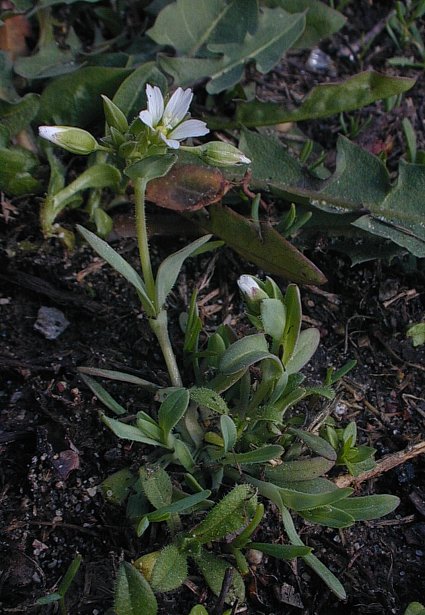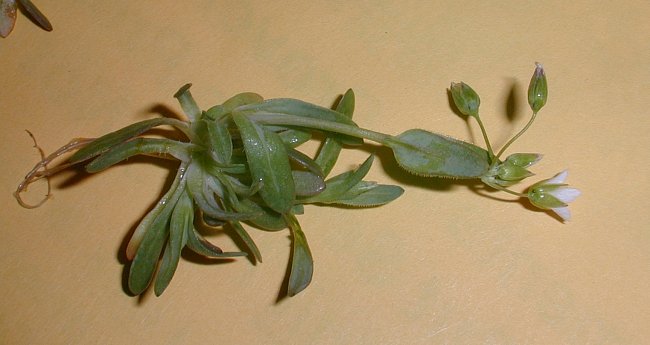Description: This plant is a winter or spring annual that becomes 3-8" long (rarely up to 12" long), forming multiple unbranched stems at its base. These stems are erect, or they can sprawl across the ground. There are patches of fine white hair along the length of each stem, otherwise it is glabrous. The basal leaves are up to 2" long and ½" across, but they are usually closer to half this size. The opposite leaves along each stem are about 1" long and ¼" across or a little smaller. The basal leaves are oblanceolate and taper to a petiole-like base, while the cauline leaves are oblanceolate, lanceolate, or oblong. Both kinds of leaves are glabrous except for their margins, which are smooth and slightly ciliate. The foliage of Jagged Chickweed is pale bluish green or greyish green. Each stem terminates in a small umbel of 1-8 flowers. The flowers of an umbel bloom only one or two at a time, rather than simultaneously. Each flower is about ¼" across, consisting of 5 white petals, 5 green sepals, 3-5 stamens, and 5 white styles. The petals are somewhat narrow and have jagged tips. The sepals are lanceolate or narrowly ovate with membranous margins. The blooming period usually occurs during mid-spring and lasts about 2 weeks for a colony of plants, although some colonies bloom during the late spring. After the blooming period has been completed, each plant rapidly becomes straw-colored (stramineus) and dried out, forming seed capsules. Each capsule is ribbed and cylindrical, open at the top, with 6 small teeth along its upper rim that are curled backward. The small seeds are rectangular-oblong and minutely bumpy; they are indented in the middle and along one side. This requires at least 10x magnification to see. The root system is shallow and fibrous. This plant spreads by reseeding itself, occasionally forming large colonies.

Cultivation:
Growth
occurs during the spring when temperatures are cool and moisture levels
are rather high. Full or partial sun and sterile soil with clay, sand,
or gravel are preferred. Periods of drought are tolerated. This plant
often flowers and sets seed before lawns are regularly mowed.
Range & Habitat:
The non-native Jagged Chickweed is common in the southern half of
Illinois, uncommon
is NE Illinois, and apparently absent in NW Illinois (see Distribution
Map). This species is native to Eurasia.
Habitats include grassy or gravelly areas along railroads and roads,
lawns, nursery plots, and sterile waste areas. Disturbed areas with
scant vegetation are preferred. This species is probably spreading
northward and westward.
Faunal Associations:
Information about faunal associations is limited and somewhat
speculative, but it is probably similar to other chickweeds. The
flowers produce nectar and pollen, which occasionally attract flies,
including Syrphid flies. Small short-tongued bees may visit the flowers
as well. Mourning Doves and various sparrows probably eat the seeds to
a limited extent. The Cottontail Rabbit may eat the foliage during
early to mid-spring when little else is available.

Photographic
Location:
Along a roadside in Urbana, Illinois, where the presence of hard-pan
clay impeded the establishment of turf grass. In addition, a plant was
photographed indoors. Jagged Chickweed is fairly common along roadsides
as it appears to tolerate roadside salt and pollution to a greater
extent than turf grass.
Comments:
This is one of the first annual plants to bloom during the spring,
although it is often overlooked by passersby. This species is unique
because of the jagged tips of the petals; other closely related species
in the Pink family with small white flowers have petals that are
notched, deeply divided, or smooth along their tips. The foliage of
Jagged Chickweed is more bluish green or greyish green than the foliage
of most Cerastium spp. (Mouse-Eared Chickweeds) and
Stellaria spp. (Chickweeds). The indentation of
the seeds is another unusual characteristic, although this requires a
good hand lens to see.